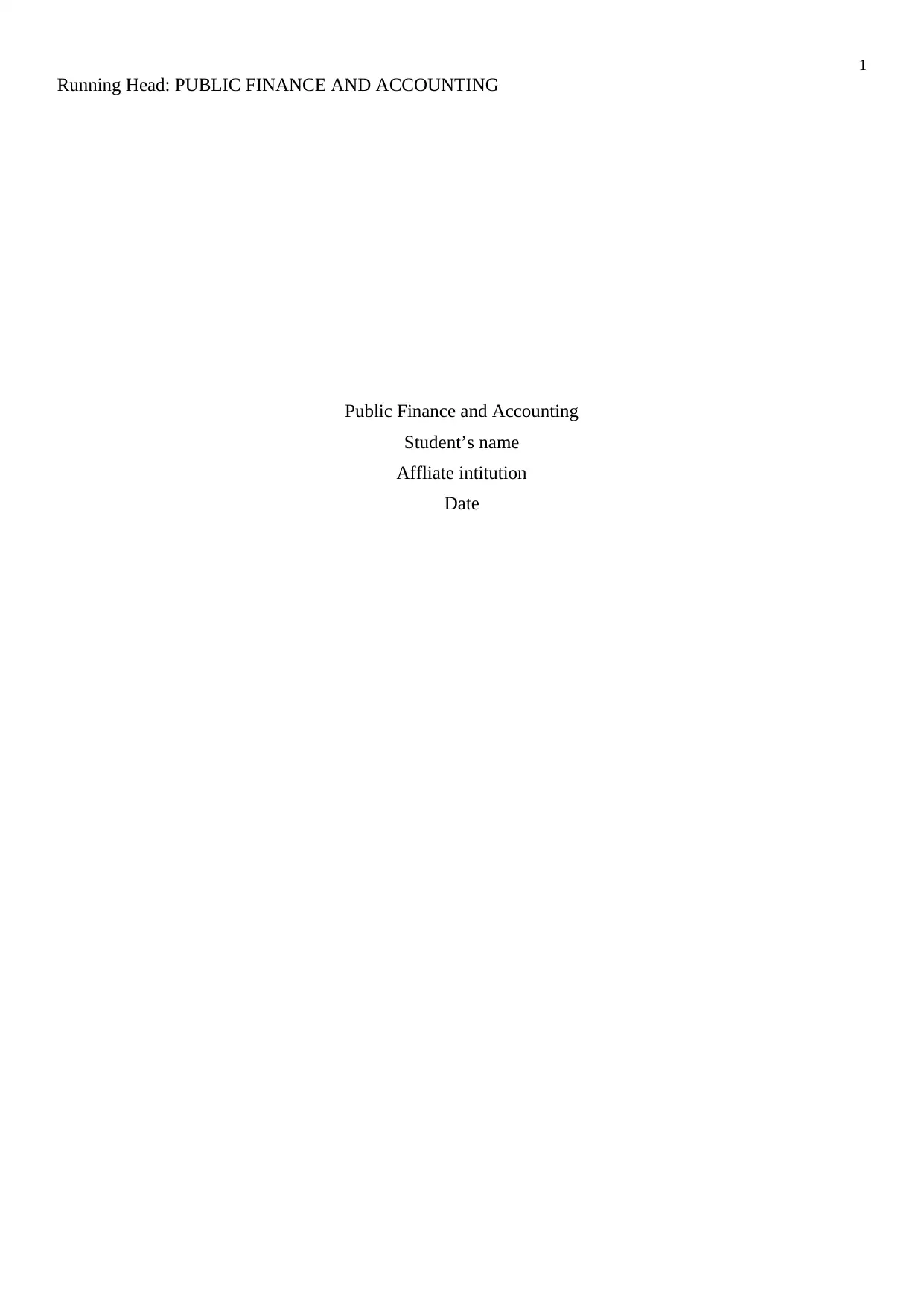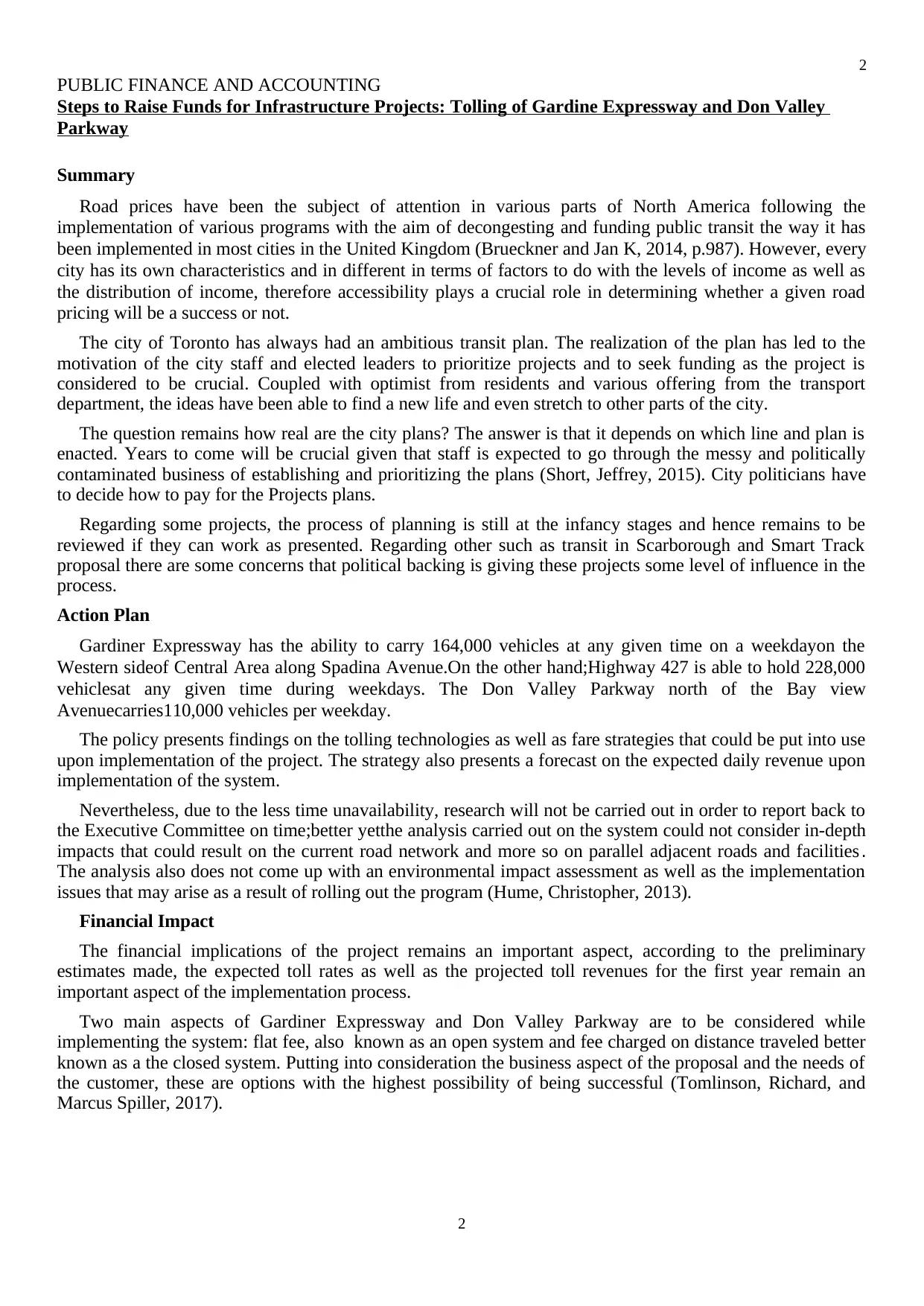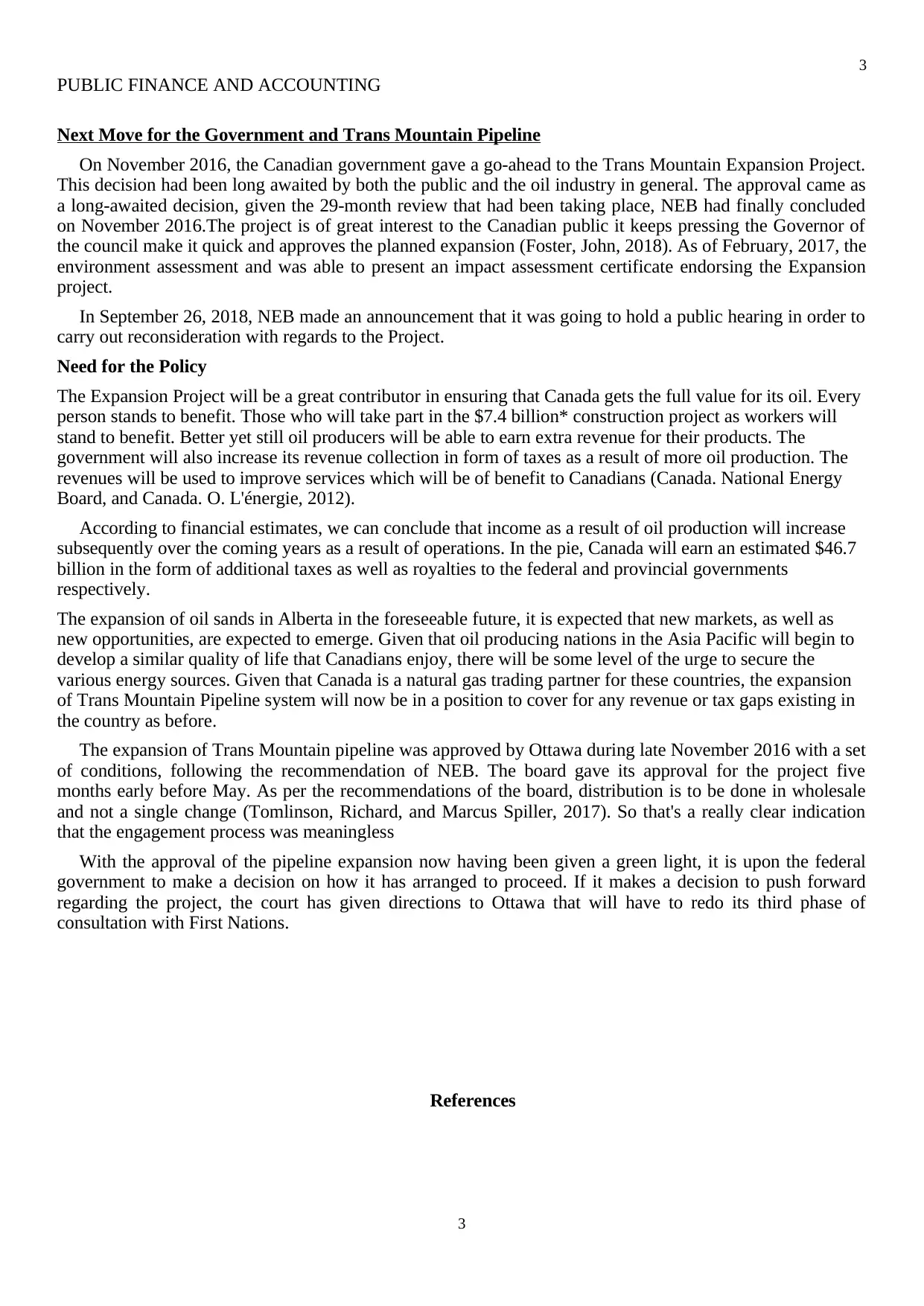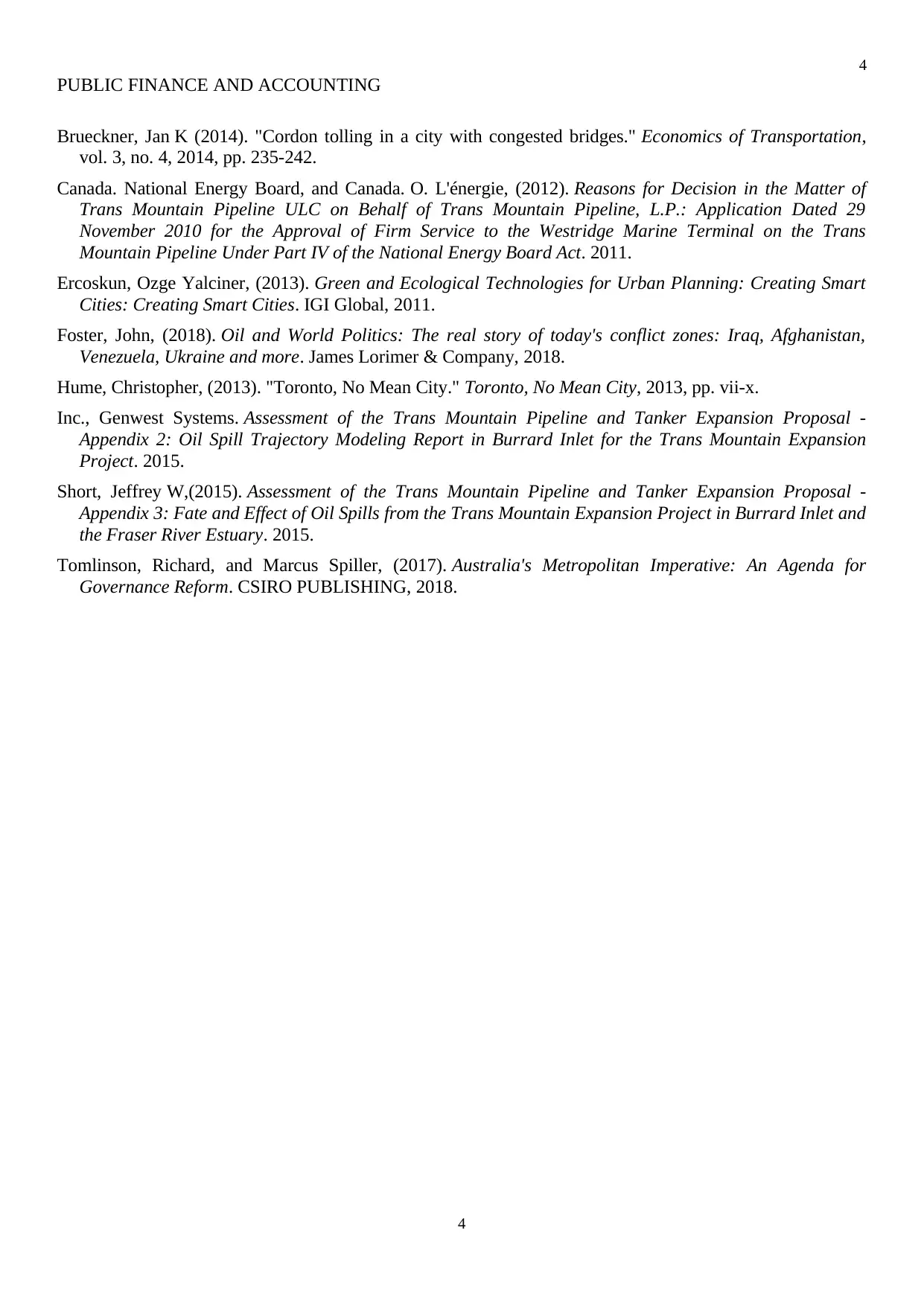Steps to Raise Funds for Infrastructure Projects: Tolling of Gardine Expressway and Don Valley Parkway
VerifiedAdded on 2022/11/14
|4
|1574
|209
AI Summary
This article discusses the steps to raise funds for infrastructure projects through tolling of Gardine Expressway and Don Valley Parkway. It also covers the financial impact and the next move for the government and Trans Mountain Pipeline.
Contribute Materials
Your contribution can guide someone’s learning journey. Share your
documents today.

1
Running Head: PUBLIC FINANCE AND ACCOUNTING
Public Finance and Accounting
Student’s name
Affliate intitution
Date
Running Head: PUBLIC FINANCE AND ACCOUNTING
Public Finance and Accounting
Student’s name
Affliate intitution
Date
Secure Best Marks with AI Grader
Need help grading? Try our AI Grader for instant feedback on your assignments.

2
PUBLIC FINANCE AND ACCOUNTING
Steps to Raise Funds for Infrastructure Projects: Tolling of Gardine Expressway and Don Valley
Parkway
Summary
Road prices have been the subject of attention in various parts of North America following the
implementation of various programs with the aim of decongesting and funding public transit the way it has
been implemented in most cities in the United Kingdom (Brueckner and Jan K, 2014, p.987). However, every
city has its own characteristics and in different in terms of factors to do with the levels of income as well as
the distribution of income, therefore accessibility plays a crucial role in determining whether a given road
pricing will be a success or not.
The city of Toronto has always had an ambitious transit plan. The realization of the plan has led to the
motivation of the city staff and elected leaders to prioritize projects and to seek funding as the project is
considered to be crucial. Coupled with optimist from residents and various offering from the transport
department, the ideas have been able to find a new life and even stretch to other parts of the city.
The question remains how real are the city plans? The answer is that it depends on which line and plan is
enacted. Years to come will be crucial given that staff is expected to go through the messy and politically
contaminated business of establishing and prioritizing the plans (Short, Jeffrey, 2015). City politicians have
to decide how to pay for the Projects plans.
Regarding some projects, the process of planning is still at the infancy stages and hence remains to be
reviewed if they can work as presented. Regarding other such as transit in Scarborough and Smart Track
proposal there are some concerns that political backing is giving these projects some level of influence in the
process.
Action Plan
Gardiner Expressway has the ability to carry 164,000 vehicles at any given time on a weekdayon the
Western sideof Central Area along Spadina Avenue.On the other hand;Highway 427 is able to hold 228,000
vehiclesat any given time during weekdays. The Don Valley Parkway north of the Bay view
Avenuecarries110,000 vehicles per weekday.
The policy presents findings on the tolling technologies as well as fare strategies that could be put into use
upon implementation of the project. The strategy also presents a forecast on the expected daily revenue upon
implementation of the system.
Nevertheless, due to the less time unavailability, research will not be carried out in order to report back to
the Executive Committee on time;better yetthe analysis carried out on the system could not consider in-depth
impacts that could result on the current road network and more so on parallel adjacent roads and facilities.
The analysis also does not come up with an environmental impact assessment as well as the implementation
issues that may arise as a result of rolling out the program (Hume, Christopher, 2013).
Financial Impact
The financial implications of the project remains an important aspect, according to the preliminary
estimates made, the expected toll rates as well as the projected toll revenues for the first year remain an
important aspect of the implementation process.
Two main aspects of Gardiner Expressway and Don Valley Parkway are to be considered while
implementing the system: flat fee, also known as an open system and fee charged on distance traveled better
known as a the closed system. Putting into consideration the business aspect of the proposal and the needs of
the customer, these are options with the highest possibility of being successful (Tomlinson, Richard, and
Marcus Spiller, 2017).
2
PUBLIC FINANCE AND ACCOUNTING
Steps to Raise Funds for Infrastructure Projects: Tolling of Gardine Expressway and Don Valley
Parkway
Summary
Road prices have been the subject of attention in various parts of North America following the
implementation of various programs with the aim of decongesting and funding public transit the way it has
been implemented in most cities in the United Kingdom (Brueckner and Jan K, 2014, p.987). However, every
city has its own characteristics and in different in terms of factors to do with the levels of income as well as
the distribution of income, therefore accessibility plays a crucial role in determining whether a given road
pricing will be a success or not.
The city of Toronto has always had an ambitious transit plan. The realization of the plan has led to the
motivation of the city staff and elected leaders to prioritize projects and to seek funding as the project is
considered to be crucial. Coupled with optimist from residents and various offering from the transport
department, the ideas have been able to find a new life and even stretch to other parts of the city.
The question remains how real are the city plans? The answer is that it depends on which line and plan is
enacted. Years to come will be crucial given that staff is expected to go through the messy and politically
contaminated business of establishing and prioritizing the plans (Short, Jeffrey, 2015). City politicians have
to decide how to pay for the Projects plans.
Regarding some projects, the process of planning is still at the infancy stages and hence remains to be
reviewed if they can work as presented. Regarding other such as transit in Scarborough and Smart Track
proposal there are some concerns that political backing is giving these projects some level of influence in the
process.
Action Plan
Gardiner Expressway has the ability to carry 164,000 vehicles at any given time on a weekdayon the
Western sideof Central Area along Spadina Avenue.On the other hand;Highway 427 is able to hold 228,000
vehiclesat any given time during weekdays. The Don Valley Parkway north of the Bay view
Avenuecarries110,000 vehicles per weekday.
The policy presents findings on the tolling technologies as well as fare strategies that could be put into use
upon implementation of the project. The strategy also presents a forecast on the expected daily revenue upon
implementation of the system.
Nevertheless, due to the less time unavailability, research will not be carried out in order to report back to
the Executive Committee on time;better yetthe analysis carried out on the system could not consider in-depth
impacts that could result on the current road network and more so on parallel adjacent roads and facilities.
The analysis also does not come up with an environmental impact assessment as well as the implementation
issues that may arise as a result of rolling out the program (Hume, Christopher, 2013).
Financial Impact
The financial implications of the project remains an important aspect, according to the preliminary
estimates made, the expected toll rates as well as the projected toll revenues for the first year remain an
important aspect of the implementation process.
Two main aspects of Gardiner Expressway and Don Valley Parkway are to be considered while
implementing the system: flat fee, also known as an open system and fee charged on distance traveled better
known as a the closed system. Putting into consideration the business aspect of the proposal and the needs of
the customer, these are options with the highest possibility of being successful (Tomlinson, Richard, and
Marcus Spiller, 2017).
2

3
PUBLIC FINANCE AND ACCOUNTING
Next Move for the Government and Trans Mountain Pipeline
On November 2016, the Canadian government gave a go-ahead to the Trans Mountain Expansion Project.
This decision had been long awaited by both the public and the oil industry in general. The approval came as
a long-awaited decision, given the 29-month review that had been taking place, NEB had finally concluded
on November 2016.The project is of great interest to the Canadian public it keeps pressing the Governor of
the council make it quick and approves the planned expansion (Foster, John, 2018). As of February, 2017, the
environment assessment and was able to present an impact assessment certificate endorsing the Expansion
project.
In September 26, 2018, NEB made an announcement that it was going to hold a public hearing in order to
carry out reconsideration with regards to the Project.
Need for the Policy
The Expansion Project will be a great contributor in ensuring that Canada gets the full value for its oil. Every
person stands to benefit. Those who will take part in the $7.4 billion* construction project as workers will
stand to benefit. Better yet still oil producers will be able to earn extra revenue for their products. The
government will also increase its revenue collection in form of taxes as a result of more oil production. The
revenues will be used to improve services which will be of benefit to Canadians (Canada. National Energy
Board, and Canada. O. L'énergie, 2012).
According to financial estimates, we can conclude that income as a result of oil production will increase
subsequently over the coming years as a result of operations. In the pie, Canada will earn an estimated $46.7
billion in the form of additional taxes as well as royalties to the federal and provincial governments
respectively.
The expansion of oil sands in Alberta in the foreseeable future, it is expected that new markets, as well as
new opportunities, are expected to emerge. Given that oil producing nations in the Asia Pacific will begin to
develop a similar quality of life that Canadians enjoy, there will be some level of the urge to secure the
various energy sources. Given that Canada is a natural gas trading partner for these countries, the expansion
of Trans Mountain Pipeline system will now be in a position to cover for any revenue or tax gaps existing in
the country as before.
The expansion of Trans Mountain pipeline was approved by Ottawa during late November 2016 with a set
of conditions, following the recommendation of NEB. The board gave its approval for the project five
months early before May. As per the recommendations of the board, distribution is to be done in wholesale
and not a single change (Tomlinson, Richard, and Marcus Spiller, 2017). So that's a really clear indication
that the engagement process was meaningless
With the approval of the pipeline expansion now having been given a green light, it is upon the federal
government to make a decision on how it has arranged to proceed. If it makes a decision to push forward
regarding the project, the court has given directions to Ottawa that will have to redo its third phase of
consultation with First Nations.
References
3
PUBLIC FINANCE AND ACCOUNTING
Next Move for the Government and Trans Mountain Pipeline
On November 2016, the Canadian government gave a go-ahead to the Trans Mountain Expansion Project.
This decision had been long awaited by both the public and the oil industry in general. The approval came as
a long-awaited decision, given the 29-month review that had been taking place, NEB had finally concluded
on November 2016.The project is of great interest to the Canadian public it keeps pressing the Governor of
the council make it quick and approves the planned expansion (Foster, John, 2018). As of February, 2017, the
environment assessment and was able to present an impact assessment certificate endorsing the Expansion
project.
In September 26, 2018, NEB made an announcement that it was going to hold a public hearing in order to
carry out reconsideration with regards to the Project.
Need for the Policy
The Expansion Project will be a great contributor in ensuring that Canada gets the full value for its oil. Every
person stands to benefit. Those who will take part in the $7.4 billion* construction project as workers will
stand to benefit. Better yet still oil producers will be able to earn extra revenue for their products. The
government will also increase its revenue collection in form of taxes as a result of more oil production. The
revenues will be used to improve services which will be of benefit to Canadians (Canada. National Energy
Board, and Canada. O. L'énergie, 2012).
According to financial estimates, we can conclude that income as a result of oil production will increase
subsequently over the coming years as a result of operations. In the pie, Canada will earn an estimated $46.7
billion in the form of additional taxes as well as royalties to the federal and provincial governments
respectively.
The expansion of oil sands in Alberta in the foreseeable future, it is expected that new markets, as well as
new opportunities, are expected to emerge. Given that oil producing nations in the Asia Pacific will begin to
develop a similar quality of life that Canadians enjoy, there will be some level of the urge to secure the
various energy sources. Given that Canada is a natural gas trading partner for these countries, the expansion
of Trans Mountain Pipeline system will now be in a position to cover for any revenue or tax gaps existing in
the country as before.
The expansion of Trans Mountain pipeline was approved by Ottawa during late November 2016 with a set
of conditions, following the recommendation of NEB. The board gave its approval for the project five
months early before May. As per the recommendations of the board, distribution is to be done in wholesale
and not a single change (Tomlinson, Richard, and Marcus Spiller, 2017). So that's a really clear indication
that the engagement process was meaningless
With the approval of the pipeline expansion now having been given a green light, it is upon the federal
government to make a decision on how it has arranged to proceed. If it makes a decision to push forward
regarding the project, the court has given directions to Ottawa that will have to redo its third phase of
consultation with First Nations.
References
3

4
PUBLIC FINANCE AND ACCOUNTING
Brueckner, Jan K (2014). "Cordon tolling in a city with congested bridges." Economics of Transportation,
vol. 3, no. 4, 2014, pp. 235-242.
Canada. National Energy Board, and Canada. O. L'énergie, (2012). Reasons for Decision in the Matter of
Trans Mountain Pipeline ULC on Behalf of Trans Mountain Pipeline, L.P.: Application Dated 29
November 2010 for the Approval of Firm Service to the Westridge Marine Terminal on the Trans
Mountain Pipeline Under Part IV of the National Energy Board Act. 2011.
Ercoskun, Ozge Yalciner, (2013). Green and Ecological Technologies for Urban Planning: Creating Smart
Cities: Creating Smart Cities. IGI Global, 2011.
Foster, John, (2018). Oil and World Politics: The real story of today's conflict zones: Iraq, Afghanistan,
Venezuela, Ukraine and more. James Lorimer & Company, 2018.
Hume, Christopher, (2013). "Toronto, No Mean City." Toronto, No Mean City, 2013, pp. vii-x.
Inc., Genwest Systems. Assessment of the Trans Mountain Pipeline and Tanker Expansion Proposal -
Appendix 2: Oil Spill Trajectory Modeling Report in Burrard Inlet for the Trans Mountain Expansion
Project. 2015.
Short, Jeffrey W,(2015). Assessment of the Trans Mountain Pipeline and Tanker Expansion Proposal -
Appendix 3: Fate and Effect of Oil Spills from the Trans Mountain Expansion Project in Burrard Inlet and
the Fraser River Estuary. 2015.
Tomlinson, Richard, and Marcus Spiller, (2017). Australia's Metropolitan Imperative: An Agenda for
Governance Reform. CSIRO PUBLISHING, 2018.
4
PUBLIC FINANCE AND ACCOUNTING
Brueckner, Jan K (2014). "Cordon tolling in a city with congested bridges." Economics of Transportation,
vol. 3, no. 4, 2014, pp. 235-242.
Canada. National Energy Board, and Canada. O. L'énergie, (2012). Reasons for Decision in the Matter of
Trans Mountain Pipeline ULC on Behalf of Trans Mountain Pipeline, L.P.: Application Dated 29
November 2010 for the Approval of Firm Service to the Westridge Marine Terminal on the Trans
Mountain Pipeline Under Part IV of the National Energy Board Act. 2011.
Ercoskun, Ozge Yalciner, (2013). Green and Ecological Technologies for Urban Planning: Creating Smart
Cities: Creating Smart Cities. IGI Global, 2011.
Foster, John, (2018). Oil and World Politics: The real story of today's conflict zones: Iraq, Afghanistan,
Venezuela, Ukraine and more. James Lorimer & Company, 2018.
Hume, Christopher, (2013). "Toronto, No Mean City." Toronto, No Mean City, 2013, pp. vii-x.
Inc., Genwest Systems. Assessment of the Trans Mountain Pipeline and Tanker Expansion Proposal -
Appendix 2: Oil Spill Trajectory Modeling Report in Burrard Inlet for the Trans Mountain Expansion
Project. 2015.
Short, Jeffrey W,(2015). Assessment of the Trans Mountain Pipeline and Tanker Expansion Proposal -
Appendix 3: Fate and Effect of Oil Spills from the Trans Mountain Expansion Project in Burrard Inlet and
the Fraser River Estuary. 2015.
Tomlinson, Richard, and Marcus Spiller, (2017). Australia's Metropolitan Imperative: An Agenda for
Governance Reform. CSIRO PUBLISHING, 2018.
4
1 out of 4
Your All-in-One AI-Powered Toolkit for Academic Success.
+13062052269
info@desklib.com
Available 24*7 on WhatsApp / Email
![[object Object]](/_next/static/media/star-bottom.7253800d.svg)
Unlock your academic potential
© 2024 | Zucol Services PVT LTD | All rights reserved.